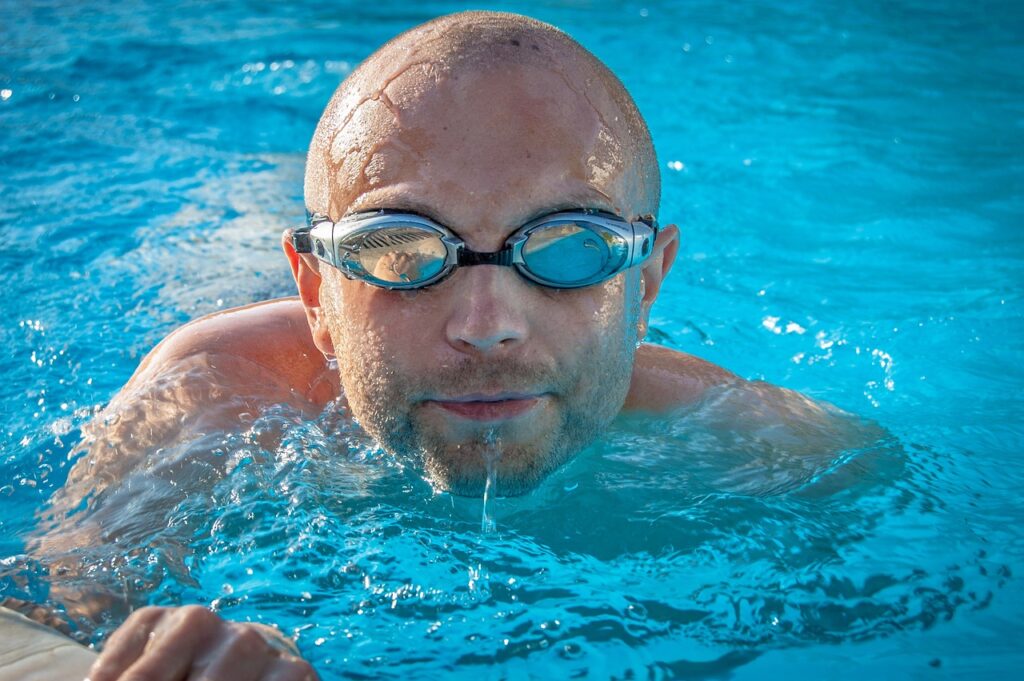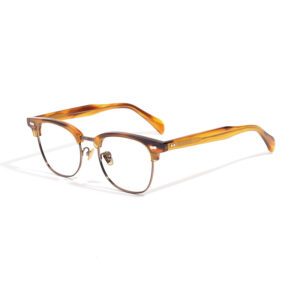Acetate frames are well-loved in the eyewear industry for their lightweight, durable, and flexible nature. They’re not just practical but also visually appealing, thanks to their broad range of transparency, vibrant colors, and finishes. However, the quality of acetate frames can vary significantly, and that largely depends on the manufacturing process. So, how exactly are these frames made, and what can be done to ensure they are of the highest quality? Let’s dive into the entire production process step by step, and I’ll share some tips along the way to help you get the best results.
1. Material Preparation
Before we even think about making the frames, there’s a crucial step that can’t be skipped: preparing the materials. The main ingredient here is the acetate sheet, but we also need accessories like wire cores and lenses. Getting these materials ready is the foundation for everything that follows.
1.1 Acetate Cutting

First things first, let’s talk about acetate sheets. These sheets are what give acetate frames their distinctive look, with sizes typically around 170*1400mm. The thickness of these sheets plays a crucial role in determining the final shape and strength of the frames. Here’s how the thickness breaks down:
- 6.0mm: Commonly used for the front part of the frames.
- 3.5mm to 4.0mm: Typically used for the temples.
- 8.0mm: Often used when a thicker, more durable front is desired, providing a more substantial feel and a bold design.
- 10.0mm: Used for ultra-thick frames, which are popular in certain fashion-forward designs where the bulkier style is a key element.
These thicknesses not only influence the frame’s durability but also affect the design possibilities, from sleek and slim to bold and chunky. The quality of these sheets directly impacts the frame’s final color and pattern, so thorough inspection is essential before moving forward. Once we’re satisfied with the quality, we cut the acetate sheets into smaller blocks, which will be easier to work with in the subsequent steps.
1.2 Roasting Acetate
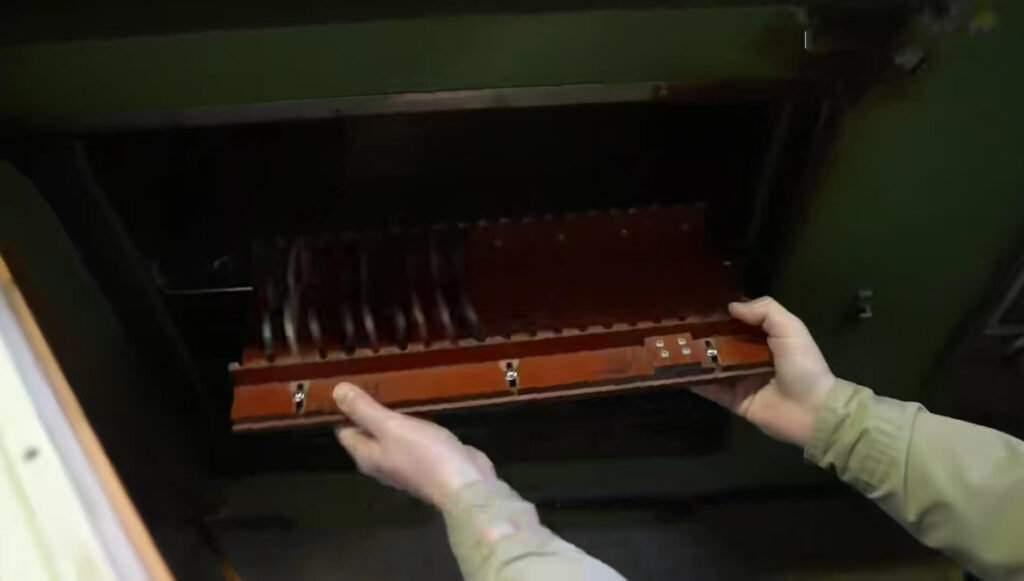
Now, here’s a crucial step that often goes unnoticed: roasting the acetate. Why do we roast it? Well, acetate has a tendency to shrink, which could deform the frames. To prevent this, we roast the blocks after cutting them. The trick lies in the details—roast them too much, and they become brittle; too little, and they might still shrink later on. After many trials, we’ve nailed down the best practice: roast the acetate blocks at 60 degrees Celsius for a full week. This might seem like a long time, but it’s essential for achieving the stability needed in high-quality frames.
2. Front Process
Once our materials are prepped and ready, it’s time to start shaping the frames. This part, known as the front process, is where the magic happens. It’s also the most complex part of production, often requiring high-end CNC (Computer Numerical Control) machines. The front process involves several steps and usually takes about 15 days to complete.
2.1 Bridge Bending
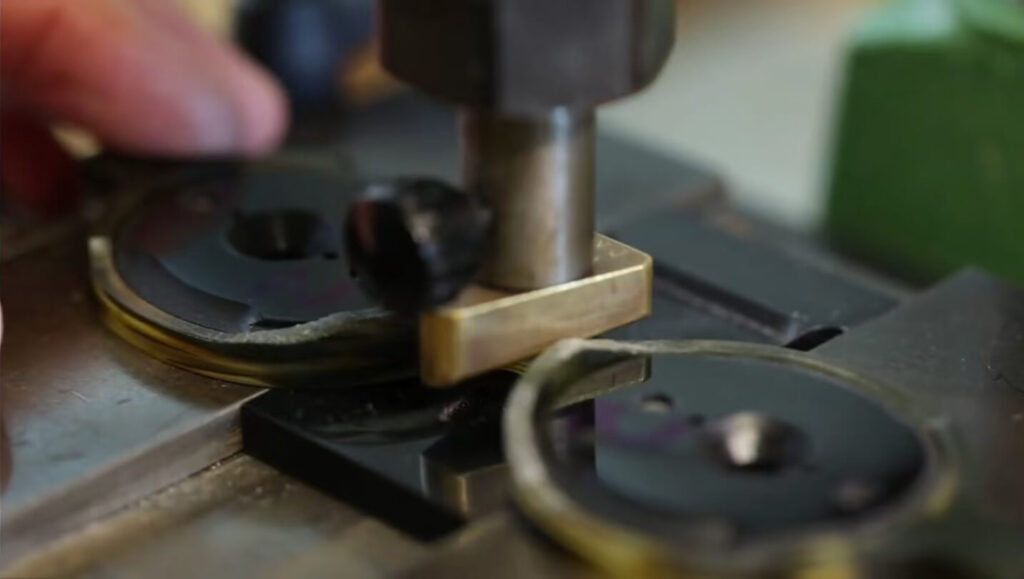
The first shaping step involves bending the bridge of the frame, which is where it rests on the nose. We use specialized bridge bending machines that apply heat and pressure to the middle of the acetate block, creating that essential curve for the nose bridge. This step is vital for both the fit and the comfort of the final eyewear.
2.2 End Piece Lamination

Next, we focus on the end pieces—the parts of the frame that connect to the temples. These pieces aren’t on the same plane as the rest of the front, so we laminate small acetate pieces onto the ends of the block. To maximize material usage, we often cut these small pieces from other parts of the front block, like the eye socket area. Once these are in place, the CNC machine will trim them to the exact size needed for a perfect fit.
2.3 Nose Pad Lamination

Just like the end pieces, the nose pads need to be laminated onto the frame. However, the material we use here is a bit different because the nose pads are in direct contact with the skin. We either purchase specialized acetate nose pads or cut them ourselves from the same high-quality materials. These pads are typically about 15*7 mm in size and are carefully positioned on the frame for maximum comfort.
2.4 CNC Programming

With all the prep work done, it’s time to bring in the CNC machine. This machine will precisely cut the frame according to the design. But here’s the thing: the CNC machine only does what it’s programmed to do. That means the quality of the final product depends heavily on the skill of the engineers writing the program. Even a small mistake in the coding can lead to issues down the line. That’s why our engineers never stop testing and adjusting the program until they get it just right. And even then, we don’t leave it all to the machine—we set up a strict inspection routine to catch any issues early on. We check the first 20 blocks to make sure everything’s on track and then continue to inspect every 100th block to ensure consistent quality.
2.5 Hand Crafting

While CNC machines are incredibly precise, they’re not perfect. Sometimes, you’ll find that a cutting path was skipped, or a small detail was overlooked. In these cases, handcrafting comes into play. For instance, if the machine missed a cut, there might be scraps left on the frame that need to be removed by hand. While it’s best to avoid this by fine-tuning the CNC program from the start, having skilled artisans on hand to fix any mistakes ensures that the final product is up to standard.
2.6 Front Bending

After the CNC cutting is complete, the frames are shaped but still flat. To get that classic curved look, we use molds that are already shaped according to the desired curve. These molds, with base curves like 4D, 6D, 8D, and 10D, give the frames their final shape, ensuring they fit comfortably on the face.
2.7 Soaking in Acetone
Before we move on to polishing, we need to clean up the frames. This involves soaking the frames in hot acetone water to remove any surface scraps or burrs left from the CNC cutting. Not only does this clean the frames, but it also gives them a shiny finish, making them look as good as they feel.
2.8 Tumbling Polish

Polishing is where the frames start to really shine—literally. We use a tumbling process, where the frames are placed in barrels with wood pellets specifically designed for acetate. This process is done in three stages:
- Rough Tumbling: We use larger wood pellets to smooth out the cutting edges. This stage usually takes at least 12 hours.
- Middle Tumbling: Smaller pellets are used to reach areas that the larger ones couldn’t. This stage can take up to 36 hours.
- Shiny Tumbling: Finally, the smallest pellets are used to give the frames that polished, glossy finish. This last stage typically takes about 24 hours.
Timing is crucial in each stage, and we keep detailed records to ensure that every frame goes through the entire process correctly.
2.9 Hand Polishing

Even after tumbling, some areas of the frame may need extra attention. This is where hand polishing comes in. Workers use grinding wheels to polish specific spots that might have been missed by the tumbling process. While this method takes longer—about 240 sets of eyewear per day per worker—it’s worth it for the enhanced finish it provides. Combining tumbling polish with hand polishing gives us the best results in both efficiency and quality.
3. Temple Process

Now, let’s talk about the temples—the parts of the frame that go over your ears. The temple process is a bit simpler than the front process, and it can be done simultaneously to save time. Generally, this process takes around 15 days.
3.1 Engraving the Spring Hinge
If the frames are designed with a spring hinge, the first step is to engrave a groove in the temple for the hinge to fit into. This is a specialized process that isn’t needed for frames with regular hinges.
3.2 Temple Shooting

Acetate temples require a metal wire core inside to keep them stable and prevent them from bending out of shape. The temple shooting process involves heating the acetate until it’s soft and then using a machine to insert the wire core in the correct position. This step is crucial for the long-term durability of the frames.
3.3 Planing Off Extra Thickness
Unlike the front process, which relies heavily on CNC machines, the temples are shaped by planing off excess material. This is done using a semi-automatic planning machine, which requires constant tweaking and inspection to get the best results. This method is particularly effective for smaller orders. However, if the order is large or requires high precision, dedicated molds might be a better option, even though they come with an extra cost of around $300 per set.
3.4 Rounding the Edges
After planing, the edges of the temples can be quite sharp. To make them comfortable to wear, we use a small grinding wheel to round off these edges. Sometimes, handcrafting is needed to smooth out hard-to-reach areas, like the ends of the temples.
3.5 Tumbling Polish
The tumbling polish process for temples is similar to that for the front, with one key difference: we cover the metal hinges with a protective gel to prevent the paint from fading during the tumbling process. Once the tumbling is complete, the gel is removed, leaving the hinges intact and the temples polished.
3.6 Hand Polish

After tumbling, the temples are hand-polished to ensure a smooth, glossy finish. Since temples are a bit easier to polish than the front of the frames, this step is usually quicker.
4. Assembling
With both the fronts and temples ready, it’s time to bring everything together in the assembly process. This final stage, which takes about 10 days, involves connecting the different parts of the frame, along with other finishing touches like lens cutting, silk printing, and final adjustments.
4.1 Assembling the Front and Temples

The first step in assembly is to connect the fronts and temples using small screws. This might sound simple, but it’s a critical step that ensures the integrity and stability of the entire frame. After assembling, we hand polish the frames to remove any scratches that might have occurred during the process. A thorough inspection follows to ensure that everything is perfect before moving on.
4.2 Lens Cutting
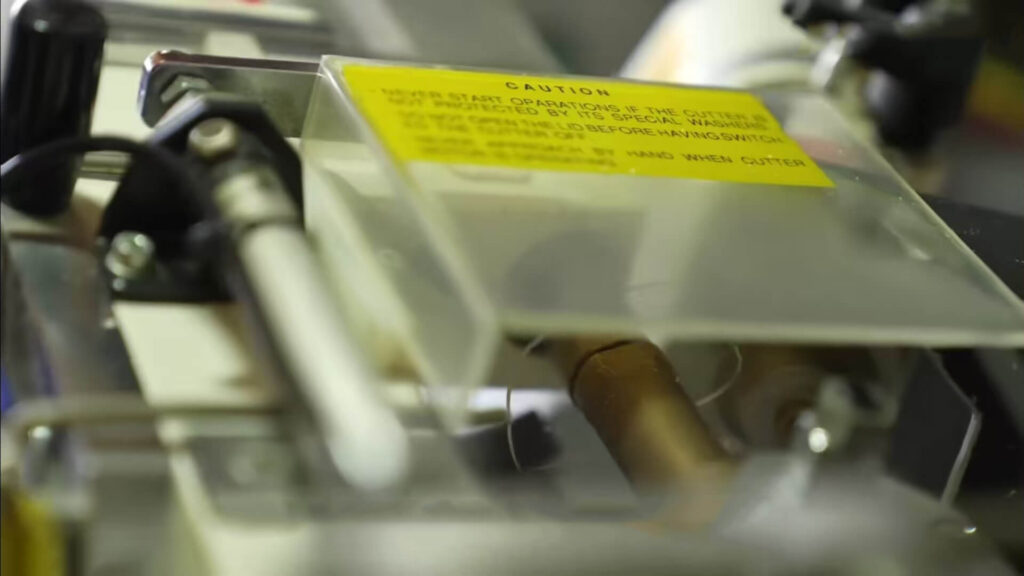
At this point, it’s time to cut the lenses. Whether we’re dealing with optical lenses or sunglasses lenses, they need to be cut to fit the frames perfectly. The lenses typically arrive from suppliers as round shapes with the required base curve. White lenses are fairly universal, but sunglasses lenses can vary significantly, and some buyers prefer to use their own trusted suppliers for this part of the process.
4.3 Silk Printing

Silk printing is where we add the finishing touches, like printing the frame size on the inner side of the temple or the brand name on the outer side of the lens or temple. Small logos can also be printed on the temples if desired.
Get Your Quote Now!
Curious about the cost of custom logo branding for eyewear?
Our competitive pricing ensures you get high-quality logo customization to enhance your brand’s visibility!
4.4 Lens Mounting

Mounting the lenses into the frames can be a bit tricky, especially if the frames have a unique design. It’s crucial to follow the engineer’s instructions closely to ensure that both the lenses and the frames remain undamaged during this process.
4.5 Adjustment

The final adjustment is crucial to make sure the frames fit perfectly according to the engineer’s design. Acetate is a bit stubborn when it comes to adjusting—sometimes, the frames will shift back to their original shape if they’re not handled correctly. To stabilize the shape, we keep the adjusted frames in a controlled environment at 24 degrees Celsius for 24 hours. After this, we make any final tweaks needed.
5. Final Inspections
Once all the production work is done, it’s time for a thorough inspection. Both the manufacturer and the buyer have a role in this, though their approaches differ slightly.
5.1 Quality Control – Factory Side

On the factory side, a wise manufacturer knows the importance of a final product inspection. Catching any defects before the product reaches the buyer is essential. If any issues are found, the product is either sent back for rework or discarded if it’s beyond repair.
5.2 Cleaning & Packaging


Once the products pass inspection, they go through ultrasonic cleaning to remove any fingerprints, oil stains, or other residues. Workers wear white gloves during the packaging process to keep the frames clean. The packaging process is detailed and follows strict guidelines. For example, the frames are carefully sleeved and placed in poly bags before being boxed. With a growing demand for eco-friendly packaging, many buyers now prefer sustainable materials for sleeves and poly bags.
Receive Custom Guidance
Looking for the perfect custom eyewear to represent your brand?
Reach out to Eyewearbeyond for expert guidance on choosing the best materials, styles, and customizations for your eyewear collection!
5.3 Customer Inspection
The final step before shipping is the buyer’s inspection. Since many buyers are located far away, they often hire third-party inspection companies to handle this task. This practice is common in the eyewear industry, and these companies usually conduct an AQL (Acceptable Quality Limit) sampling inspection. However, if a buyer prefers a full inspection, they need to inform the manufacturer in advance. If the products don’t meet the agreed quality standards, the manufacturer is responsible for reworking them until they pass inspection.
-

Acetate Eyewear Wholesale Suppliers – LT1115
$80.00 Select options This product has multiple variants. The options may be chosen on the product page -

Bulk Wholesale Acetate Eyewear – 882284
$80.00 Select options This product has multiple variants. The options may be chosen on the product page -
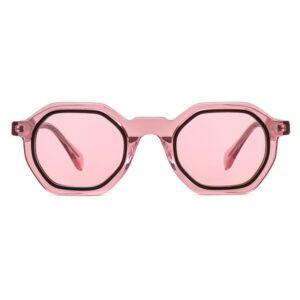
Bulk Wholesale Acetate Sunglasses – 90009
$90.00 Select options This product has multiple variants. The options may be chosen on the product page -

Buy Acetate Eyewear in Bulk – CO1140
$80.00 Select options This product has multiple variants. The options may be chosen on the product page
Conclusion
In a nutshell, producing acetate eyewear is a meticulous process that typically takes about 35 to 45 days for sample production. When it comes to mass production, the timeline extends to around 2 months. However, these timelines can vary depending on the complexity of the design and whether materials are prepped in advance. While I’ve covered the key steps in this process, there’s so much more to it than what can be captured in a single article. Each eyewear model presents its own unique challenges, and overcoming them requires a combination of technical skill, experience, and a deep understanding of the craft. Eyewear production is as much an art as it is a science, and mastering it takes time, patience, and dedication.
FAQ: A Step by Step Guide: How to Make Acetate Eyewear
1. What makes acetate a popular material for eyewear frames?
Acetate is popular because it’s lightweight, durable, flexible, and visually appealing. It offers a wide range of transparency, vibrant colors, and finishes, making it a versatile choice for both functional and fashionable eyewear.
2. What is the significance of material preparation in acetate eyewear production?
Material preparation is crucial because the quality of the acetate sheets and accessories like wire cores and lenses directly impacts the durability, appearance, and overall quality of the final eyewear. Proper preparation sets the foundation for the entire production process.
3. Why is roasting acetate important, and how is it done?
Roasting acetate is important to prevent shrinkage, which can cause the frames to deform. The process involves roasting the acetate blocks at 60 degrees Celsius for a week, which stabilizes the material and ensures the frames maintain their shape.
4. What role does CNC programming play in the production of acetate frames?
CNC programming is critical because it dictates how the acetate frames are cut and shaped. Accurate programming ensures that the frames are cut precisely according to the design, reducing errors and improving the quality of the final product.
5. How are the frames polished after they are shaped?
The frames are polished through a multi-stage process. First, they undergo tumbling polish, where they are placed in barrels with wood pellets to smooth out the edges and surfaces. This is followed by hand polishing to address any areas that require extra attention, ensuring a high-quality, glossy finish.
6. What is the purpose of handcrafting in the acetate eyewear production process?
Handcrafting is used to fix any minor issues or imperfections that CNC machines might miss. Skilled artisans manually refine the frames, ensuring that the final product meets the highest standards of quality and precision.
7. How are the temples of acetate frames made and polished?
The temple process includes engraving grooves for spring hinges, inserting metal wire cores for stability, and shaping the temples by planing off excess material. After shaping, the temples are polished using both tumbling and hand polishing techniques to ensure a smooth, comfortable finish.
8. What steps are involved in assembling acetate eyewear?
Assembling acetate eyewear involves connecting the fronts and temples with screws, cutting lenses to fit the frames, silk printing branding details, mounting the lenses, and making final adjustments to ensure a perfect fit. This process ensures that all parts of the eyewear come together seamlessly.
9. How is quality controlled during the acetate eyewear production process?
Quality control is conducted at multiple stages, including after the frames are assembled and before they are packaged. Any frames that don’t meet the required standards are either reworked or discarded. The final inspection is crucial to ensure that only high-quality products are delivered to customers.
10. What are the typical production timelines for acetate eyewear?
Sample production usually takes 35 to 45 days, while mass production can take around 2 months. These timelines can vary depending on the complexity of the design and whether the materials are pre-prepared.
11. What is the customer inspection process before acetate eyewear is shipped?
Before shipping, many buyers hire third-party inspection companies to conduct a final quality check. This often involves AQL (Acceptable Quality Limit) sampling to ensure the eyewear meets the agreed standards. If the products don’t pass inspection, the manufacturer is responsible for reworking them until they do.
12. Can eco-friendly materials be used for packaging acetate eyewear?
Yes, many buyers request eco-friendly materials for packaging, such as sustainable sleeves and poly bags. These materials help reduce environmental impact and are becoming increasingly popular in the eyewear industry.
Clarify Your Questions
Still have questions about custom eyewear services?
Contact us for expert insights and tailored solutions!

